Geology Reference
In-Depth Information
displacement
variation along
each fold
1500
A
B
Karatoo
section locations
1000
abcde
500
anticline 1
anticline 2
anticline 1
0
anticline 2
Displacement Trade-Offs
Between Overlapping Folds
10
cross sections of displacement
anticline
2
anticline 1
5
a
b
c
d
e
Gory
Baybeiche
0
0
5
0
1
5
1
SE
NW
distance (km)
Fig. 10.17
Transfer of displacement among
en echelon
folds.
A. Models of displacement transfer between overlapping folds. As displacement decreases toward the nose of one
fold, it increases in the adjacent fold. Shortening recorded by bed-length changes in each fold shows displacement
compensation, which smoothes the integrated displacement variation between the two folds. B. Topographic profiles
across the oppositely plunging and overlapping termini of the Gory Baybeiche and Karatoo folds, Tien Shan,
Kyrgyzstan. The lines of the topographic profiles are oriented approximately perpendicular to the fold axes. Except
low on the flanks where Cenozoic strata remain, the topographic surface of both folds is defined primarily by the
only slightly dissected regional unconformity that represents the upper limit of the bedrock, such that a similar
structural level is being measured in each fold. Note the similarity of the topographic profiles to that predicted when
deformation is transferred between two oppositely growing structures (A): as one dies, the other grows, and the total
shortening remains fairly constant along strike.
of different base-level elevations on either flank
of the fold (Ellis and Densmore, 2006). Assuming
equilibrium slopes and equal channel concavity
(Figs 8.4 and 8.5) on both flanks, the drainage
divide will also be displaced toward the flank
with the higher base level. If the base level
subsequently changes, for example, via drainage
capture that incises an intramontane basin, the
divide will shift again in order to achieve a
balance with the new base levels and the pattern
of rock uplift (Fig. 10.16A(iv)).
The Tien Shan not only provides excellent
examples of bedrock-cored folds that grew
over the past few million years, but also illus-
trates how displacement may be transferred
between multiple structures. Imagine a conver-
gence between two semi-rigid blocks with
growing folds accommodating the shortening
between them. In zones of overlap of the fold
tips, one would expect a trade-off in the amount
of shortening: as the shortening that one fold
accommodated decreased toward its tip, the
shortening in the overlapping fold should
increase (Fig. 10.17). Based on analysis of an
approximately 90-m DEM, topographic profiles
oriented perpendicular to the fold axes and
across the overlapping tips of two folds
illustrate this accommodation of shortening
between the two folds (Burbank
et al
., 1999).
DEM-based topographic profiles can serve to
illustrate such shortening accurately only when
the topographic surface approximately coin-
cides with a structural marker. In the Tien Shan,
the exhumed unconformity that cuts across the
bedrock and that underlies the weak Cenozoic
strata serves this purpose.














































































































































